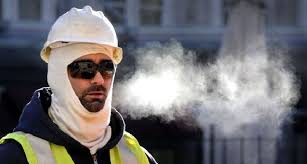It rained this morning, so what? Why can’t you still work on my job?!
The truth is, there are many things that can cause a delay in your pavement or pavement maintenance project. Weather, being just one. Here are some examples of weather reasons your job could be delayed:
 Rain: Why can’t you pave in the rain? This is simple. Asphalt is temperature sensitive. It has to remain hot in order to install and cure properly. Much like throwing water on a hot pool deck or in a hot frying pan, rain can very quickly cool the asphalt beyond usable temps. If installed anyway, it will not look esthetically pleasing to the eye, will not compact properly and will generally fail.
Rain: Why can’t you pave in the rain? This is simple. Asphalt is temperature sensitive. It has to remain hot in order to install and cure properly. Much like throwing water on a hot pool deck or in a hot frying pan, rain can very quickly cool the asphalt beyond usable temps. If installed anyway, it will not look esthetically pleasing to the eye, will not compact properly and will generally fail.
If your project site is holding water or too soggy after a rain event, your project will be delayed until it has had time to dry out. Excess moisture prevents asphalt from adhering properly and can disrupt compaction, if particularly soupy.
Rain today pushes every job on the schedule effected by that rain event. For example, it rains today and we are unable to work on a few, if not all of our projects. Effectively, every project on the schedule following the rain event will be pushed by however many days we were unable to work due to the weather.
What about sealcoat? Sealcoat is primarily composed of liquid and sand. Add more liquid (like rain) and you dilute the mixture. It doesn’t install evenly, doesn’t dry properly, and doesn’t last. If it rains while the sealcoat is still wet, it will wash off your asphalt and into your drainage ponds or systems. This is not good! We will not sealcoat in the rain or on days with high probability of rain. This is for the integrity of the sealcoat and the safety of your ponds!

Cold: We are in Florida, so we are lucky. Instead of shutting down for the entire winter season, we only have a relatively few cold weather days where the temperature is low enough to prevent work. Asphalt installed at a thickness of 1½” or greater, the temps must be 40 degrees and rising with no wind for the asphalt to perform as intended. For thicknesses 1” or less, the temps must be 60 degrees and rising. Otherwise the asphalt will cool to quickly, compaction will not be achieved, it will look ugly and the asphalt will generally fail.
These are the same reasons we DO shut down our sealcoat operation for the entire winter season. Sealcoat needs warmth and sunshine. Installing on cold, short days, would be against manufacturers specifications, will void the warranty, and will create failure.
High Winds: Now, high winds in July likely won’t stop your paving job. It would possibly delay your sealcoat job, because sealcoat is liquid and applied with a sprayer. If winds are high enough to blow the majority of the sealcoat on the surrounding cars and buildings instead of straight down onto the asphalt, we will likely stop the project.
High winds, plus cold temperatures can absolutely delay your project, as it will cause the asphalt to cool even faster than colder temperatures alone (Think about hot soup – blowing on the spoon cools the soup faster than just letting it sit).
We understand that project delays are inconvenient and annoying. Please trust that if we delay your project for weather reasons, it is because we are committed to providing you with the best project possible. That cannot happen in certain weather conditions.


